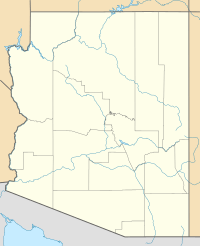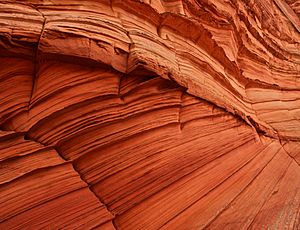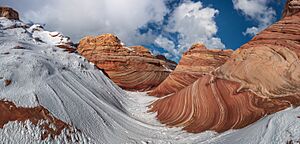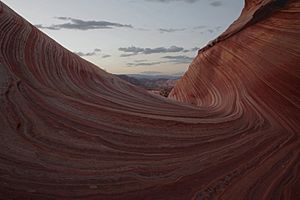The Wave (Arizona) facts for kids
Quick facts for kids The Wave |
|
|---|---|
| Highest point | |
| Elevation | 5,225 ft (1,593 m) |
| Geography | |
| Location | Coconino County, Arizona, U.S. |
| Geology | |
| Age of rock | Jurassic |
The Wave is an amazing rock formation made of sandstone. You can find it in Arizona, USA, close to the border with Utah. This special place is part of the Coyote Buttes area, which is inside the Paria Canyon-Vermilion Cliffs Wilderness. It's managed by the Bureau of Land Management (BLM).
Many hikers and photographers love The Wave because of its bright colours and wavy shapes. It's also a challenging place to reach. Because The Wave is very delicate and many people want to see it, only a few visitors are allowed each day. You need a special permit to visit. These permits are given out through a lottery system. Some permits are available online months ahead of time. Others are available two days before your visit, but you need to be in a specific area to apply. If you get a permit, you'll receive a map and information to help you find your way.
Contents
How The Wave Was Formed
The Wave is made of Navajo Sandstone from the Jurassic period, which was millions of years ago. It has two main U-shaped dips carved into the rock. One is about 62 feet (19 m) wide and 118 feet (36 m) long. The other is smaller, about 7 feet (2 m) wide and 52 feet (16 m) long.
Wind and Water Shaping the Rock
At first, these dips were carved by water flowing over the sandstone. Over time, less water flowed into the area. Now, the wind does most of the work. The wind blows through the dips, slowly carving the sandstone. This creates the unique steps and ridges you see on the walls. These patterns show how the wind usually blows through The Wave.
Layers of Sandstone
The Wave shows many layers of sand that were once part of huge sand dunes. These layers are called cross-beds. They formed as sand was blown by the wind during the Jurassic period. The different colours and patterns you see are from these layers. Some layers are harder than others because of how the sand was cemented together. This means some parts wear away faster than others. This is why The Wave has its thin ridges and wavy look. The sandstone is very fragile, especially these ridges. So, visitors must walk carefully to avoid breaking them.
Ancient Footprints in the Sand
In some parts of The Wave, you can see layers of sandstone that were squished or moved before they turned into rock. Scientists think this happened when dinosaurs walked and stomped on the sand long ago. You can even find dinosaur footprints and fossil burrows made by ancient insects like beetles in the Navajo Sandstone nearby.
Capturing The Wave's Beauty
The best time to take photos of The Wave is around the middle of the day. This is when there are no shadows in the center, making the colours pop. But shadows in the early morning or late afternoon can also create dramatic pictures. After it rains, small pools of water can form. These pools might have tiny creatures called tadpole shrimps living in them for a few days.
Just above The Wave, there's another area many people call "the Second Wave." Its colours are not as bright, but it's still interesting to see and photograph. Many famous landscape photographers consider it a must-see spot.
Getting a Permit to Visit
The Wave is located in the Paria Canyon-Vermilion Cliffs Wilderness. To visit, you need a special day-use permit from the Bureau of Land Management (BLM).
How Permits Are Given Out
The BLM only allows 64 permits per day for the North Coyote Buttes area, where The Wave is.
- Online Lottery: 48 permits are available through an online lottery. You can apply four months before the month you want to visit.
- Daily Lottery: The remaining 16 permits are available through a daily lottery. You must apply two days before your planned hike. You need to be in a specific "geofenced" area (around Kanab, Utah, or Page, Arizona) and use the Recreation.gov app or website on your phone.
Spring and autumn are the most popular times to visit. It's very hard to get a permit during these months, as many people want to see The Wave. It's especially popular with European tourists because it was shown in a German documentary film called Fascinating Nature (1996).
Trails to The Wave
There are four main starting points, called trailheads, to get into Paria Canyon and reach The Wave. However, there are no marked trails or signs to guide you directly to The Wave. This helps keep the area wild and natural. The White House trailhead is the most common starting point.
Wire Pass Trailhead
The shortest hike to The Wave starts at the Wire Pass Trailhead. This trailhead is about 8.3 miles (13.4 km) south of U.S. Route 89 on a dirt road called House Rock Valley Road. This road can be tricky to drive on, especially after rain.
From the Wire Pass Trailhead, it's about a 3 miles (4.8 km) hike across open desert to The Wave. This means the round-trip is nearly 6 miles (9.7 km). You'll climb about 350 feet (110 m) in height. Even though it's the shortest path, it can be a bit challenging.
Hiking Tips
- Weather: Summers can be very hot, with temperatures often above 100 °F (38 °C). It's best to start your hike early in the morning during warmer months.
- Conditions: Be ready for tough desert conditions in any season. This includes strong winds, blowing sand, and very little shade.
- Navigation: Finding The Wave can be tricky because there's no marked trail. You'll walk over open sandstone, sand dunes, and sandy dry riverbeds. The BLM gives every permit holder a detailed guide sheet. This guide helps you navigate using a compass, GPS, or just by looking at the land. It has photos and directions for six checkpoints on your way there and back. It's a good idea to study this guide carefully before you start your hike.
- Guides: If you're not comfortable hiking in the wilderness on your own, the BLM can provide a list of approved guides who can lead you to The Wave.
|
See also
 In Spanish: The Wave para niños
In Spanish: The Wave para niños






